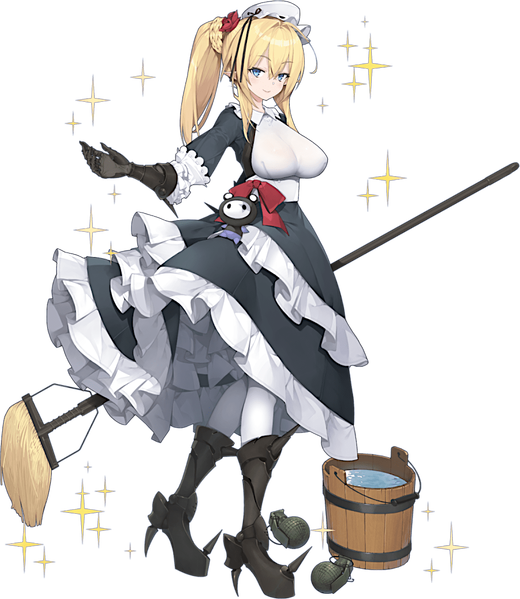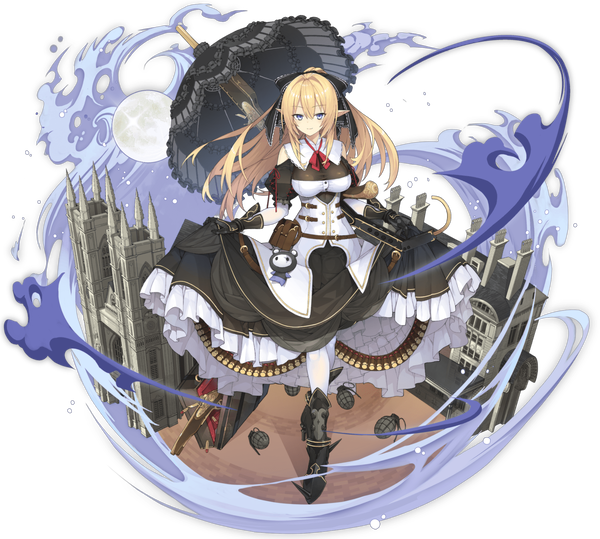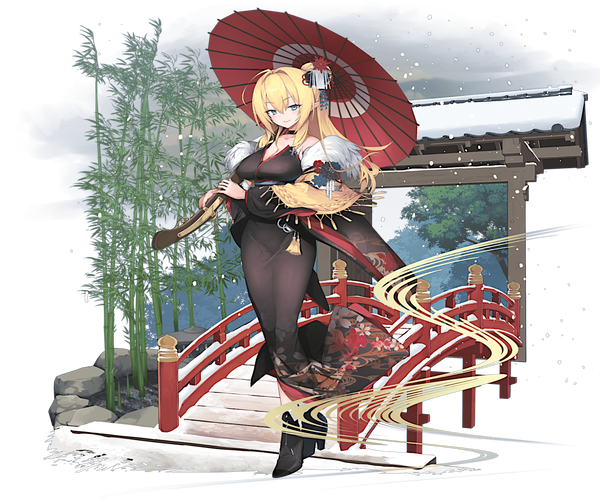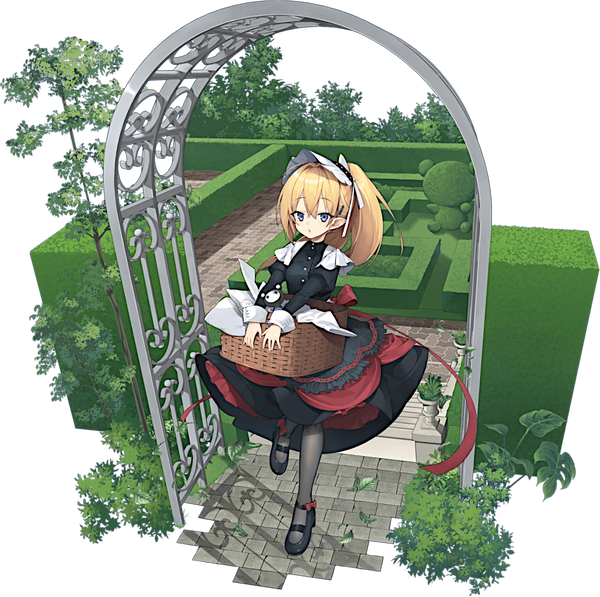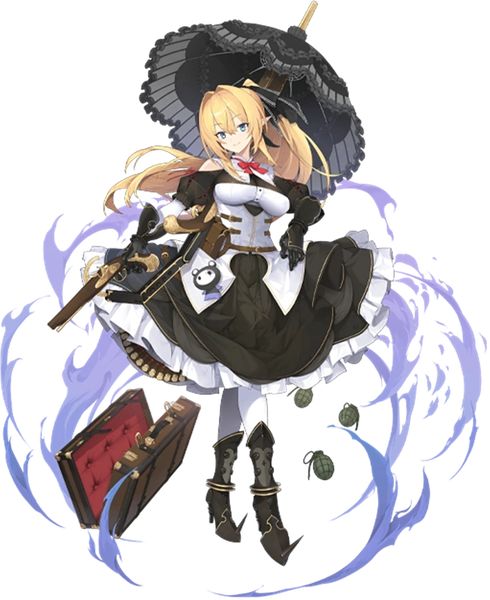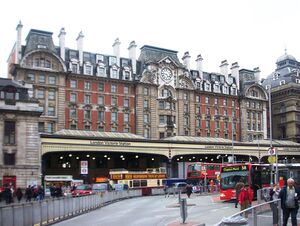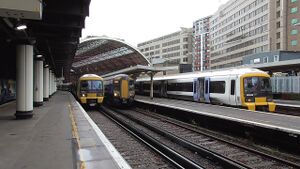Victoria
| Victoria | |||||
|---|---|---|---|---|---|
| Japanese Name | ヴィクトリア | ||||
| Weapon | |||||
| Race | Half-Elf | ||||
| Nationality | |||||
| Birthday | October 1 | ||||
| Constellation | Libra | ||||
| Talents | Being an escort | ||||
| Likes | Guns | ||||
| Dislikes | Being sneaky, Standing still | ||||
| Strengths | Nerves of steel | ||||
| Weaknesses | Brute force methods even if things can be resolved peacefully | ||||
| Hobbies | Weight training | ||||
Sir Conductor, it's a pleasure to meet you. I'm Victoria. I'm the maid assigned to Lady Paddington. I will do my best to not bring shame to such a noble as her. I will warn you that I have a bad habit of saying some nasty things sometimes. If that ever happens, just give me a spanking.
Layers
| Icon | Title | Release Date | Where to Obtain |
|---|---|---|---|
| [Martial Arts Maid] Victoria | 2022 January 11 (EN) | [Sage of Wisdom and the Squire of Annihilation] Limited Gacha | |
| [Preparing Cold Drinks] Victoria | 2021 July 16 | [Spa Resort Treasure Hall] Event Reward | |
| [Refreshing Change of Pace] Victoria | 2023 January 1 | [Hare Racing Mt. Cannon] Event Reward | |
| [Maid of Destruction] Victoria | 2022 January 11 (EN) | [Sage of Wisdom and the Squire of Annihilation] Limited Gacha | |
| [Maid in New Year's Eve] Victoria | 2023 January 1 | [Hare Racing Mt. Cannon] Step Up Gacha | |
| [Lollipop Maid] Victoria | 2023 April 28 | [Lolly Lollipop Rollin' Girls] Limited Gacha |
Skills
Trivia
- Victoria's birthday is the opening date of Victoria station (London Brighton and South Coast Railway) in 1860.
- Victoria's maid design originated from the maids serving the Buckingham Palace (the residence of the King) and Westminster Palace (Parliament Building), located in the City of Westminster district, where London Victoria Station also resides in. In the Victorian era domestic service was the second largest category of employment in England and Wales, after agricultural work.
- Victoria's half-elf heritage is possibly a reference to the British and French graves of two Unknown Warriors, which holds an unidentified member of the British armed forces killed on a European battlefield during the First World War, simultaneously with a similar interment of a French unknown soldier at the Arc de Triomphe in France, making both graves the first to honor the unknown dead of the First World War. The British Unknown Warrior is buried in Westminster Abbey, London.
- Lucy Bear can also be seen under Victoria's possession, signifying her childhood friendship with Paddington and her oath to protect her as a house maid.
- The umbrella gun was invented in the 19th century, as a variant of the more popular cane gun. The earliest extant example of an umbrella gun may be one in Fink's collection, dated to 1860. The umbrella was made in London and marked "Armstrong reg. British Make." The handle has its own marking: "Richard Grinell 1860." (Grinnell was probably the owner.) The shaft of the umbrella is actually a rifle.
- The buildings in the background of [Maid of Destruction] is the Westminster Abbey on the left and the London Victoria Station on the right.
- The Party Skill [Hissatsu! Jaou Shoukou Ken!] (original: 必殺!邪王翔光拳!) is an iconic reference to Haou Shoukou Ken (覇王翔吼拳), a Super Special Move in the Art of Fighting, Fatal Fury and The King of Fighters series, serving as one of the signature attacks for practitioners of Kyokugenryu Karate.
- Victoria is one of six train knights who were a part of a collaboration event in Flower Knight Girl (From Beyond the World of Flowers / 花の世界の向こうから) that was held from April 15th, 2024 to April 30th, 2024. The other featured train knights were Paddington, King's Cross, Yakutsk, Yoshino, and Miyako. In the event's story mode, Paddington and Victoria were paired with Eederuwaisu / Edelweiss and Sunoofureeku / Snowflake, a noblewoman and maid from Lily Wood who have a similar close-knit relationship. Victoria and Snowflake end up competing with each other over matters such as who is better at defeating Pests and whose master is the most forgiving when it comes to their maid's numerous miscues.
Counterpart
Victoria station, also known as London Victoria, is a central London railway terminus and connected London Underground station in Victoria, in the City of Westminster, managed by Network Rail. Named after the nearby Victoria Street (not the Queen), the main line station is a terminus of the Brighton Main Line to Gatwick Airport and Brighton and the Chatham Main Line to Ramsgate and Dover via Chatham. From the main lines, trains can connect to the Catford Loop Line, the Dartford Loop Line, and the Oxted line to East Grinstead and Uckfield. The Underground station is on the Circle and District lines between Sloane Square and St James's Park, and the Victoria line between Pimlico and Green Park. The area around the station is an important interchange for other forms of transport: a local bus station is in the forecourt and Victoria Coach Station is nearby.
Victoria was built to serve both the Brighton and Chatham Main Lines, and has always had a "split" feel of being two separate stations. The Brighton station opened in 1860 with the Chatham station following two years later. It replaced a temporary terminus at Pimlico, and construction involved building the Grosvenor Bridge over the River Thames. It became immediately popular as a London terminus, causing delays and requiring upgrades and rebuilding. It was well known for luxury Pullman train services and continental boat-train trips, and became a focal point for soldiers during World War I.
By 1850, railways serving destinations to the south of London had three termini available – London Bridge, Bricklayers' Arms and Waterloo. All three were inconvenient for Central London as they terminated south of the river Thames, whereas the main centres of population, business and government were north of the river in the City of London, the West End and Westminster.
Victoria Station was designed in a piecemeal fashion to help address this problem for the London Brighton and South Coast Railway (LB&SCR) and the London Chatham and Dover Railway (LC&DR). It consisted of two adjacent main line railway stations which, from the viewpoint of passengers, were unconnected. Victoria station proved to be unexpectedly popular for both the main companies, and by 1862 there were frequent delays due to congestion at Stewarts Lane Junction.
In the early 20th century, the development and improvement of the London Underground, meant that Victoria could not compete as a cross-London service. GNR trains stopped running on 1 October 1907, with Midland ones following on June the next year. The GWR ceased to use the station for scheduled services on 21 March 1915, partly due to World War I in addition to the new Underground lines. Victoria was used as the main station for drafted soldiers, and those returning from action in the war. By the middle of the war, the station served twelve trains a day running between Victoria and Folkestone, with additional trains serving Dover. The station was regularly served with a voluntary buffet for departing soldiers, who served up to 4,000 men a day. Victoria itself did not suffer significant damage during the war, but a section of Grosvenor Bridge was destroyed after an anti-aircraft shell struck a gas main underneath it.
Following the war, memorials were built on both parts of the station. The Southern Railway side marks 626 soldiers killed or missing, while the Chatham side marks 556. A plaque marks the arrival of the body of The Unknown Warrior at Victoria on 10 November 1920. Wikipedia
Westminster Abbey, formally titled the Collegiate Church of Saint Peter at Westminster, is a large, mainly Gothic abbey church in the City of Westminster, London, England, just to the west of the Palace of Westminster. It is one of the United Kingdom's most notable religious buildings and the traditional place of coronation and a burial site for English and, later, British monarchs. Since the coronation of William the Conqueror in 1066, all coronations of English and British monarchs have occurred in Westminster Abbey. Sixteen royal weddings have occurred at the Abbey since 1100.
The Abbey is the burial site of more than 3,300 people, usually of prominence in British history: at least 16 monarchs, eight prime ministers, poets laureate, actors, scientists, military leaders, and the Unknown Warrior—the first person interred in the Abbey's Poets' Corner was Geoffrey Chaucer in 1400. As such, Westminster Abbey is sometimes described as "Britain's Valhalla", after the iconic hall of the chosen heroes in Norse mythology.
Since the coronation in 1066 of William the Conqueror, every English and British monarch (except Edward V and Edward VIII, who were never crowned) has been crowned in Westminster Abbey. In 1216, Henry III could not be crowned in London when he came to the throne, because the French prince Louis had taken control of the city, and so the king was crowned in the Church of St. Peter in Gloucester (which is now Gloucester Cathedral). This coronation was deemed by Pope Honorius III to be improper, and a further coronation was held in Westminster Abbey on 17 May 1220. Wikipedia
Map
Gallery
- Pages using Tabber parser tag
- Pages using DynamicPageList3 parser tag
- Weapon Gun
- Half-Elf
- St. Iris
- Libra
- Element Pierce
- Element Light
- Element Wind
- Train Knights
- England



